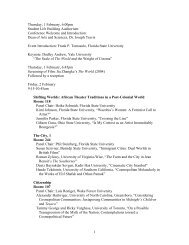Visibility now: Historicizing foreign presences in translation - English ...
Visibility now: Historicizing foreign presences in translation - English ...
Visibility now: Historicizing foreign presences in translation - English ...
Create successful ePaper yourself
Turn your PDF publications into a flip-book with our unique Google optimized e-Paper software.
Downloaded by [Florida State University], [Anne Coldiron] at 07:12 30 March 2012<br />
Translation Studies 193<br />
had to be made to sound native. S<strong>in</strong>ce <strong>in</strong>khorn terms were to be eschewed but were<br />
also needed to build vernacular languages and literatures, ambivalence about<br />
national lexicons resulted perhaps more so <strong>in</strong> England than <strong>in</strong> France, where the<br />
stricter regulations of the Académie française were not long com<strong>in</strong>g. Citizenship<br />
metaphors about naturalization, immigration and denizenry turned up <strong>in</strong> such<br />
paratexts, load<strong>in</strong>g political and economic implications onto the work of the<br />
translator. In fact, many early pr<strong>in</strong>ted paratexts, especially translators’ prefaces,<br />
used elaborate, suggestive metaphors for <strong>translation</strong> (Hermans 1985; Martín de León<br />
2010; St André 2010). These metaphors demand the reader’s attention to the<br />
complexity of the <strong>translation</strong> process itself, mak<strong>in</strong>g the translators and their work<br />
anyth<strong>in</strong>g but <strong>in</strong>visible.<br />
An extreme case of early modern visibility <strong>in</strong> <strong>translation</strong> is Thomas Watson. His<br />
Hekatompathia (1582) is a lyric sequence <strong>in</strong> which each 18-l<strong>in</strong>e poem or ‘‘passion’’ is<br />
accompanied with a prose headnote that expla<strong>in</strong>s his effort, names and sometimes<br />
quotes his subtexts <strong>in</strong> various languages, pr<strong>in</strong>ts marg<strong>in</strong>al citations to multiplelanguage<br />
subtexts, and expla<strong>in</strong>s his actions <strong>in</strong> render<strong>in</strong>g the various l<strong>in</strong>es or tropes<br />
from <strong>foreign</strong> poems. An example is the typical third-person headnote to Passion V:<br />
All this Passion (two verses only excepted) is wholly translated out of Petrarch, where he<br />
writeth,<br />
Samor non è, che dunque è quel ch’i sento?<br />
Ma s’egh è amor, per Dio che cosa, e quale?<br />
Se buona, ond’è l’effetto aspro e mortale?<br />
Seria, ond’è si dolce ogni tormento?<br />
Heere<strong>in</strong> certa<strong>in</strong>e contrarieties, whiche are <strong>in</strong>cident to him that loueth extrèemelye, are<br />
liuely expressed by a Metaphore. And it may be noted, that the Author <strong>in</strong> his first halfe<br />
verse of this <strong>translation</strong> varieth from that sense, which Chawcer vseth <strong>in</strong> translat<strong>in</strong>g the<br />
selfe same: which he doth vpon no other warrant then his owne simple priuate op<strong>in</strong>ion,<br />
which yet he will not greatly stand vpon.<br />
The poem, one of many compet<strong>in</strong>g European lyrics on this theme, then beg<strong>in</strong>s, ‘‘IF’t<br />
bée not loue I feele, what is it then?’’ The reader of this poem cannot miss and is<br />
asked to judge the translator’s work; this is apparently the desired goal and po<strong>in</strong>t of<br />
the aesthetic experience of the poem. Passion VI cont<strong>in</strong>ues the metatextual attention<br />
to the author’s work and arts as a translator:<br />
This passion is a <strong>translation</strong> <strong>in</strong>to lat<strong>in</strong>e of the selfe same sonnet of Petrarch which you<br />
red lastly alleaged, and commeth somwhat neerer vnto the Italian phrase the[n] the<br />
<strong>English</strong> doth. The Author whe[n] he translated it, was not then m<strong>in</strong>ded euer to haue<br />
imboldned him selfe so farre, as to thrust <strong>in</strong> foote amongst our english Poets. But be<strong>in</strong>ge<br />
busied <strong>in</strong> translat<strong>in</strong>g Petrarch his sonnets <strong>in</strong>to lat<strong>in</strong> new clothed this amo[n]gst many<br />
others, which one day may perchance come to light [...].<br />
A Lat<strong>in</strong> version of Passion V follows, and one cannot read it without experienc<strong>in</strong>g<br />
aesthetic contrasts <strong>in</strong> versification and syntax (i.e. language based), but also <strong>in</strong> tone<br />
and flavor (not here attributable to the poet’s ‘‘personality’’ or ‘‘subjectivity’’, s<strong>in</strong>ce<br />
both are his <strong>translation</strong>s). Is one a different poet when writ<strong>in</strong>g <strong>in</strong> different languages?<br />
A different person? The poet’s ‘‘own simple priuate op<strong>in</strong>ion’’ is not someth<strong>in</strong>g to<br />
stand on, he tells us, but the <strong>foreign</strong> prior texts of Chaucer and Petrarch are, as is the<br />
Lat<strong>in</strong> post-text by Watson himself.




